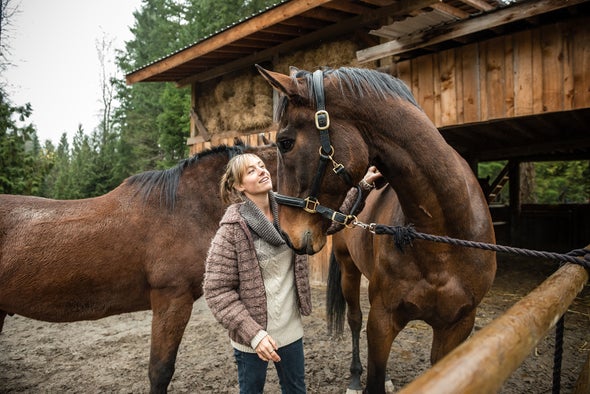(单词翻译:单击)
听力文本
This is Scientific American's 60-second Science, I'm Susanne Bard.
We recognize our friends' faces. And we're not alone. Many social animals can identify individuals of their own species by their facial features. That's important, because they need to be able to adjust their behavior depending on who they encounter. And research has shown that some species of monkeys, birds and domesticated animals can even distinguish among different faces by looking at photographs alone.
Scientists have also wondered whether domesticated animals that have coexisted with people for thousands of years can recognize different human faces. For example, we've shared more than 5,000 years of our history with horses. Plus, they can live up to 30 years and may need to retain a great deal of information about us throughout their lifetimes.
Ethologist Léa Lansade of the French National Research Institute for Agriculture, Food and Environment did an experiment to find out how well horses can recognize individual people in photographs.
She and her team first taught the horses how to "choose" between two side-by-side images by touching their noses to a computer screen. The horses were then shown photos of their current keeper alongside faces of unfamiliar humans. They had never seen photos of any of the people before. The horses correctly identified their current keeper and ignored the stranger's face about 75 percent of the time, significantly better than chance.

What's more, the horses also preferentially picked photos of their previous keeper—a person they hadn't seen in six months. In fact, even though the horses didn't get it right every single time, they were at least as accurate in picking out their previous keeper as they were at identifying their current one. The findings are in the journal Scientific Reports.
The results suggest that not only can horses differentiate between familiar and unfamiliar human faces, they intuitively understand that photographs are two-dimensional representations of real life without any other cues such as odor or sound. And they're even better at this than our oldest animal companion: the domestic dog.
In addition, horses seem to have a robust long-term memory for human faces, consistent with their long life span and history of domestication. In future experiments, the researchers would like to test whether looking at photos of people that they have had bad experiences with in the past might cause horses to act anxious or even avoidant. So maybe think twice before doing anything at a stable that might give a horse a long face.
Thanks for listening for Scientific American's 60-second Science. I'm Susanne Bard.
参考译文
这里是科学美国人——60秒科学系列,我是苏珊娜·巴德。
我们能认出朋友的模样。而具有这种能力的不只是人类。许多群居动物都能通过面部特征认出同类个体。这很重要,因为它们要能依据遇见对象的不同来调整自已的行为。研究表明,猴子、鸟类和驯养动物中有些种类甚至只看照片就能区分不同的面孔。
科学家还想知道,与人类共存了数千年的驯养动物是否能识别不同的人类面孔。例如,我们与马一起创造了5000多年的历史。此外,它们的寿命可达30年,一生中可能需要记住大量有关我们的信息。
法国国家农业、食品和环境研究所的动物行为学家莱娅·兰萨德进行了实验,以确定马识别照片中人类个体的能力有多强。
她和团队首先教会马儿用鼻子触碰电脑屏幕,在两张并排照片中进行选择。之后,她们向马儿展示了现任饲养员的照片,旁边会放不熟悉的人的照片。马儿以前从未见过任何人的照片。马儿认出了现任饲养员,无视陌生人的正确率为75%,这明显好于随机概率。
更重要的是,马儿还会优先选出以前饲养员的照片,而这是它们6个月没有见过的人。事实上,尽管马儿不是每次都选对,但至少它们挑出以前饲养员的准确率和认出现任饲养员的正确率相同。研究结果发表在《科学报告》期刊上。
研究结果表明,马不仅能区分熟悉和不熟悉的人脸,还能凭直觉理解照片是真实生命的二维表现,无需气味或声音等任何其它提示。它们在这方面的表现甚至比我们最古老的动物伙伴——家养犬——更好。
此外,马对人脸似乎有很强的长久记忆,这记忆贯穿它们长久的寿命和驯养历史。在未来实验中,研究人员想测试马儿看到过去与其有过不愉快经历的人的照片时,是否会表现出焦虑甚至回避行为。因此,在养马场做任何可能让马儿不开心的事情之前,要三思而后行。
谢谢大家收听科学美国人——60秒科学。我是苏珊娜·巴德。
译文为可可英语翻译,未经授权请勿转载!
重点讲解
重点讲解:
1. a great deal of 许多;大量;
They spent a great deal of money.
他们花了大量的钱。
2. pick out 辨认出;分辨出;
The detective-constable picked out the words with difficulty.
探警费力地辨认出这些文字。
3. differentiate between 区分;区别;辨别;
A child may not differentiate between his imagination and the real world.
儿童可能无法将自己的幻想与真实世界区分开来。
4. think twice 重新考虑;慎重考虑;思忖再三;
Think twice before doing anything rash.
不要草率行事,要三思而行。


